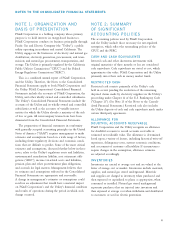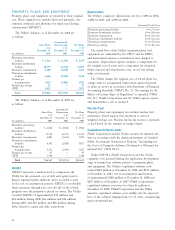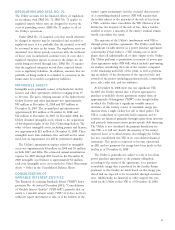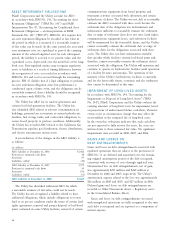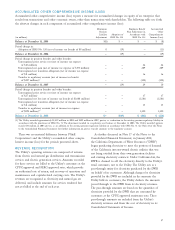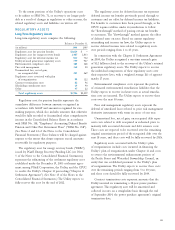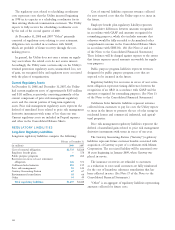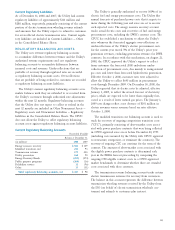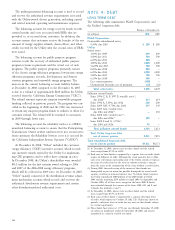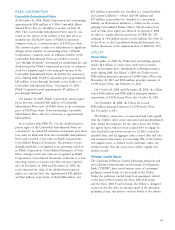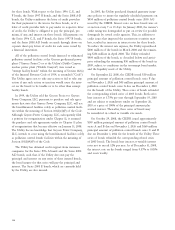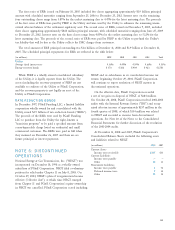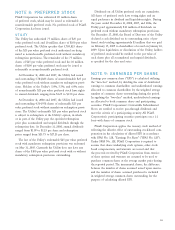PG&E 2008 Annual Report Download - page 103
Download and view the complete annual report
Please find page 103 of the 2008 PG&E annual report below. You can navigate through the pages in the report by either clicking on the pages listed below, or by using the keyword search tool below to find specific information within the annual report.
101
The regulatory assets for deferred income tax represent
deferred income tax benefi ts previously passed through to
customers and are offset by deferred income tax liabilities.
Tax benefi ts to customers have been passed through, as the
CPUC requires utilities under its jurisdiction to follow
the “fl ow-through” method of passing certain tax benefi ts
to customers. The “fl ow-through” method ignores the effect
of deferred taxes on rates. Based on current regulatory
ratemaking and income tax laws, the Utility expects to
recover deferred income taxes related to regulatory assets
over periods ranging from 1 to 45 years.
In connection with the Chapter 11 Settlement Agreement
in 2004, the Utility recognized a one-time noncash gain
of $1.2 billion related to the recovery of the Utility’s retained
generation regulatory assets. The Utility expects to recover
the individual components of these regulatory assets over
their respective lives, with a weighted average life of approxi-
mately 17 years.
Environmental compliance costs represent the portion
of estimated environmental remediation liabilities that the
Utility expects to recover in future rates as actual remedia-
tion costs are incurred. The Utility expects to recover these
costs over the next 30 years.
Price risk management regulatory assets represent the
deferral of unrealized losses related to price risk management
derivative instruments with terms in excess of one year.
Unamortized loss, net of gain, on reacquired debt repre-
sents costs related to debt reacquired or redeemed prior to
maturity with associated discount and debt issuance costs.
These costs are expected to be recovered over the remaining
original amortization period of the reacquired debt over the
next 18 years, and these costs will be fully recovered by 2026.
Regulatory assets associated with the Utility’s plan
of reorganization include costs incurred in fi nancing the
Utility’s plan of reorganization under Chapter 11 and costs
to oversee the environmental enhancement projects of
the Pacifi c Forest and Watershed Stewardship Council, an
entity that was established pursuant to the Utility’s plan
of reorganization. The Utility expects to recover these costs
over the remaining periods ranging from 5 to 30 years,
and these costs should be fully recovered by 2034.
Contract termination costs represent amounts that the
Utility incurred in terminating a 30-year power purchase
agreement. This regulatory asset will be amortized and
collected in rates on a straight-line basis through the end
of September 2014, the power purchase agreement’s original
termination date.
To the extent portions of the Utility’s operations cease
to be subject to SFAS No. 71, or recovery is no longer prob-
able as a result of changes in regulation or other reasons, the
related regulatory assets and liabilities are written off.
REGULATORY ASSETS
Long-Term Regulatory Assets
Long-term regulatory assets comprise the following:
Balance at December 31,
(in millions) 2008 2007
Regulatory asset for pension benefi ts $1,624 $ —
Regulatory asset for energy recovery bonds 1,487 1,833
Regulatory asset for deferred income tax 847 732
Utility-retained generation regulatory assets 799 947
Environmental compliance costs 385 328
Price risk management 362 20
Unamortized loss, net of gain,
on reacquired debt 225 269
Regulatory assets associated with plan
of reorganization 99 122
Contract termination costs 82 96
Scheduling coordinator costs 39 90
Other 47 22
Total regulatory assets $5,996 $4,459
Regulatory asset for pension benefi ts represents the
cumulative differences between amounts recognized in
accordance with GAAP and amounts recognized for rate-
making purposes, which also includes amounts that otherwise
would be fully recorded to Accumulated other comprehensive
income in the Consolidated Balance Sheets in accordance
with SFAS No. 158, “Employers’ Accounting Defi ned Benefi t
Pension and Other Post Retirement Plans” (“SFAS No. 158”).
(See Notes 2 and 14 of the Notes to the Consolidated
Financial Statements.) These balances will be charged against
expense to the extent that future expenses exceed amounts
recoverable for regulatory purposes.
The regulatory asset for energy recovery bonds (“ERBs”),
issued by PG&E Energy Recovery Funding LLC (see Note
5 of the Notes to the Consolidated Financial Statements),
represents the refi nancing of the settlement regulatory asset
established under the December 19, 2003 settlement agree-
ment among PG&E Corporation, the Utility, and the CPUC
to resolve the Utility’s Chapter 11 proceeding (“Chapter 11
Settlement Agreement”). (See Note 15 of the Notes to the
Consolidated Financial Statements.) The Utility expects to
fully recover this asset by the end of 2012.




